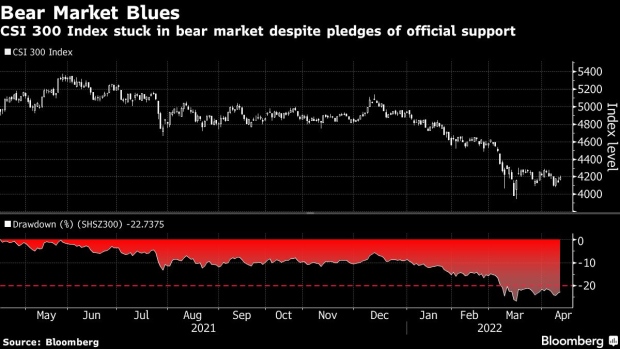Apr 18, 2022
China Jitters Mount as Easing Calls Echo Across Trading Floors
, Bloomberg News

(Bloomberg) -- Investors have a clear message to China’s policy makers: more stimulus is needed, and quickly, to reignite a stalled recovery in markets.
The People’s Bank of China decision to give lenders a modest cash boost Friday was met with declines in equities on Monday. And after data showed consumer spending took a dive in March -- pushing stocks and bonds even lower -- traders are left waiting to see what policy makers will do with a benchmark lending rate on Wednesday.
“The market needs key actionable plans for easing measures for the property sector, the regulatory overhang on tech to be removed and China’s Covid-zero policy to go away,” said Kerry Goh, chief investment officer at Kamet Capital Partners Pte. “There’s no one-size-fits-all stimulus that can revive the markets and the economy.”
Assets across the world’s second-biggest economy have tumbled as a staunch commitment to Covid-Zero, uncertainty over regulatory change and a property slowdown sapped demand. The benchmark CSI 300 Index has tumbled about 15% this year and remains in a bear market while bond yields have risen, underscoring concerns Beijing may not be doing enough to arrest slowing growth.
While the PBOC reduced the reserve requirement ratio for most banks by 25 basis points on Friday, it refrained from cutting interest rates, adopting a cautious approach to monetary easing. Chinese banks are due to decide on the loan prime rates -- the de-facto benchmark lending costs -- on April 20.
Flagging Growth
But the nation’s property market is in a slump, retail spending took a nosedive in March as lockdowns shuttered millions in their homes and the jobless rate has hit the highest since the early stages of the pandemic.
China’s Market ‘Underwhelmed’ by RRR Reduction: Street Wrap
“We see rising headwinds to China’s growth in 2022,” Zerlina Zeng, senior research analyst at CreditSights Singapore LLC, wrote in a note. The firm expects the PBOC to focus on targeted credit-easing measures to lower funding costs as part of efforts to prop up growth.
While China’s first quarter GDP numbers may mask the damage from the lockdowns across hubs, including financial powerhouse Shanghai, cracks may start to show in data ahead. That would bode ill for risk assets including stocks and credit, strategists say.
The disappearance of the premium Chinese bonds long had to Treasuries, exacerbated by a hawkish Federal Reserve, could also accelerate the exit of foreign investors from the world’s second-largest debt market, according to Daiwa Capital Markets.
“It will make it a lot more difficult for China to draw external debt inflows,” said Kevin Lai, chief economist for Asia ex-Japan. “We have long argued that the room for the PBOC to offer monetary stimulus is going to be far more limited when the Fed is turning more aggressive in its tightening campaign.”
Impatient Investors
Patience is wearing thin among stock investors as worries about the impact of the latest Covid upsurge eclipses promises of official market support. A rebound in the CSI 300 Index mid-March has petered out amid the nation’s worst Covid outbreak.
“Some wait-and-see may potentially be at play for now, but we may expect further measures to cushion growth ahead which will underpin its equity market,” said Jun Rong Yeap, market strategist at IG Asia Pte. “This will clearly not be the end of China’s easing cycle.”
©2022 Bloomberg L.P.





